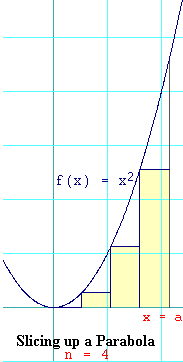

The base is length a, so if you divide it into n equal slices, each slice will be a/n wide.

The figure on the right will help you visualize how we are slicing the
area under the parabola. Here we are cutting it into four slices --
that is
Recall that
hk = f((k-1)a/n) = (k-1)2a2/n2
The width of every slice is a/n. The height of the kth slice is
Ak = (k-1)2a3/n3
Just put the expression you got in step 4 into a summation for k equal 1 to n.
n n
Atotal = å Ak = å (k-1)2a3/n3
k=1 k=1
The factor that is constant with respect to k is a3/n3. When you factor it out you get
n
Atotal = (a3/n3) å (k-1)2
k=1
The summation from step 6 is just the sum of the squares of the integers from zero to n-1. We have a formula for that. When you apply it you get
n(n-1)(2n-1)
Atotal = (a3/n3)
6
When you multiply out the polynomial you get
2n3 - 3n2 + n
Atotal = (a3/n3)
6
Now multiply through by the a3/n3:
a3 a3 a3
Atotal = - +
3 2n 6n2
Atotal = a3/3which is the actual area of the shaded region that we started with.
How to find the sum of the squares of the integers from zero to n-1: First observe what the difference of two consecutive cubes is:
n3 - (n - 1)3 = n3 - (n3 - 3n2 + 3n - 1) = 3n2 - 3n + 1Notice that we had to apply the binomial formula to unravel that.
Now observe that
n3 = (13 - 03) + (23 - 13) + (33 - 23) + ...
... + ((n-1)3 - (n-2)3) + (n3 - (n-1)3)
which works simply because everything cancels except the n3.
But isn't that just the same as saying
n
n3 = å k3 - (k-1)3
k=1
Now, turning the equation around and substituting the difference expression we got
using the binomial formula, we have:
n
å 3k2 - 3k + 1 = n3
k=1
Try this with a few small values of n to convince yourself
that it works.
The expression in the summation is itself a sum of three things. So we separate it into three summations:
n n n
å 3k2 - å 3k + å 1 = n3
k=1 k=1 k=1
Now factor the constant multipliers from each summation:
n n n
3 å k2 - 3 å k + å 1 = n3
k=1 k=1 k=1
Starting with the easiest summation, the sum from 1 to n of
1 added to itself is pretty easy. That's equal to n.
The sum the integers from 1 to n we can do the same we we did in the main text for adding integers from zero to n-1 (by writing the sum forward and backward):
S = 1 + 2 + 3 + ... + n-2 + n-1 + n S = n + n-1 + n-2 + ... + 3 + 3 + 1Clearly twice the sum is n+1 added to itself n times. So2S = n+1 + n+1 + n+1 + ... + n+1 + n+1 + n+1
n n(n+1)
å k =
k=1 2
So substituting for the two sums that we know, our equation becomes:
n n(n+1)
3 å k2 - 3 + n = n3
k=1 2
Now move all the stuff that we have resolved so far over to the right and
divide by 3
n n3 n(n+1) n
å k2 = + -
k=1 3 2 3
This gives the sum of the square integers from 1 to n. But
we wanted the sum from zero to n-1. So we have to add zero squared and
subtract n2. Of course zero squared is zero, so we ignore that.
Here is the result:
n-1 n3 n(n+1) n
å k2 = + - - n2
k=0 3 2 3
Now multiply out the n(n+1), and put everything over a common denominator:
n-1 2n3 + 3n2 + 3n - 2n - 6n2 2n3 - 3n2 + n n(2n2 - 3n + 1)
å k2 = = =
k=0 6 6 6
All that remains for you to do to finish this is to factor the quadratic on the
right.
email me at hahn@netsrq.com